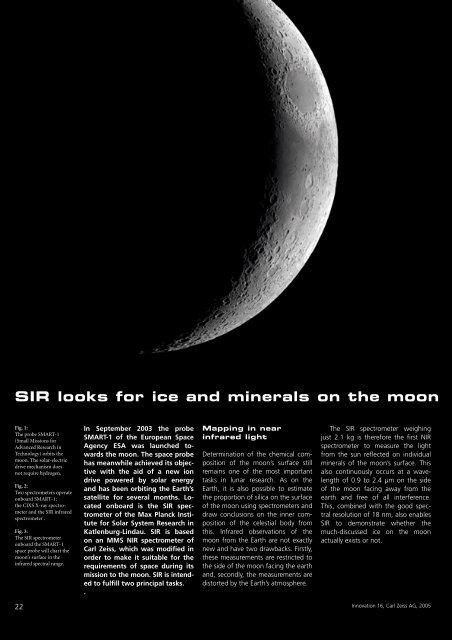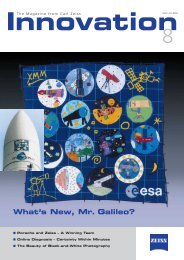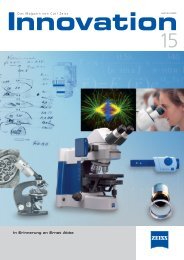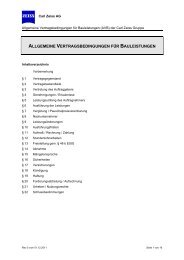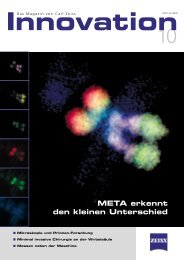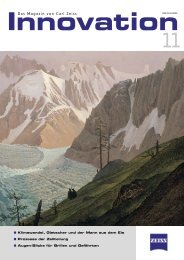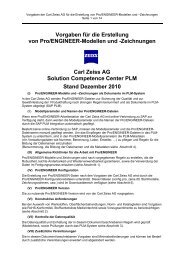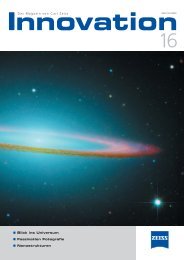Download PDF - Carl Zeiss
Download PDF - Carl Zeiss
Download PDF - Carl Zeiss
Create successful ePaper yourself
Turn your PDF publications into a flip-book with our unique Google optimized e-Paper software.
SIR looks for ice and minerals on the moon<br />
Fig. 1:<br />
The probe SMART-1<br />
(Small Missions for<br />
Advanced Research in<br />
Technology) orbits the<br />
moon. The solar-electric<br />
drive mechanism does<br />
not require hydrogen.<br />
Fig. 2:<br />
Two spectrometers operate<br />
onboard SMART-1:<br />
the CIXS X-ray spectrometer<br />
and the SIR infrared<br />
spectrometer .<br />
Fig. 3:<br />
The SIR spectrometer<br />
onboard the SMART-1<br />
space probe will chart the<br />
moon’s surface in the<br />
infrared spectral range.<br />
22<br />
In September 2003 the probe<br />
SMART-1 of the European Space<br />
Agency ESA was launched towards<br />
the moon. The space probe<br />
has meanwhile achieved its objective<br />
with the aid of a new ion<br />
drive powered by solar energy<br />
and has been orbiting the Earth’s<br />
satellite for several months. Located<br />
onboard is the SIR spectrometer<br />
of the Max Planck Institute<br />
for Solar System Research in<br />
Katlenburg-Lindau. SIR is based<br />
on an MMS NIR spectrometer of<br />
<strong>Carl</strong> <strong>Zeiss</strong>, which was modified in<br />
order to make it suitable for the<br />
requirements of space during its<br />
mission to the moon. SIR is intended<br />
to fulfill two principal tasks.<br />
.<br />
Mapping in near<br />
infrared light<br />
Determination of the chemical composition<br />
of the moon’s surface still<br />
remains one of the most important<br />
tasks in lunar research. As on the<br />
Earth, it is also possible to estimate<br />
the proportion of silica on the surface<br />
of the moon using spectrometers and<br />
draw conclusions on the inner composition<br />
of the celestial body from<br />
this. Infrared observations of the<br />
moon from the Earth are not exactly<br />
new and have two drawbacks. Firstly,<br />
these measurements are restricted to<br />
the side of the moon facing the earth<br />
and, secondly, the measurements are<br />
distorted by the Earth’s atmosphere.<br />
The SIR spectrometer weighing<br />
just 2.1 kg is therefore the first NIR<br />
spectrometer to measure the light<br />
from the sun reflected on individual<br />
minerals of the moon’s surface. This<br />
also continuously occurs at a wavelength<br />
of 0.9 to 2.4 µm on the side<br />
of the moon facing away from the<br />
earth and free of all interference.<br />
This, combined with the good spectral<br />
resolution of 18 nm, also enables<br />
SIR to demonstrate whether the<br />
much-discussed ice on the moon<br />
actually exists or not.<br />
Innovation 16, <strong>Carl</strong> <strong>Zeiss</strong> AG, 2005


